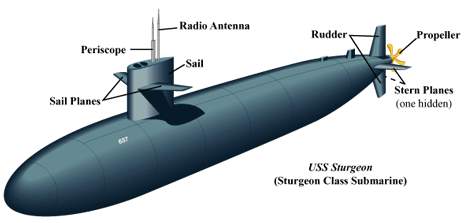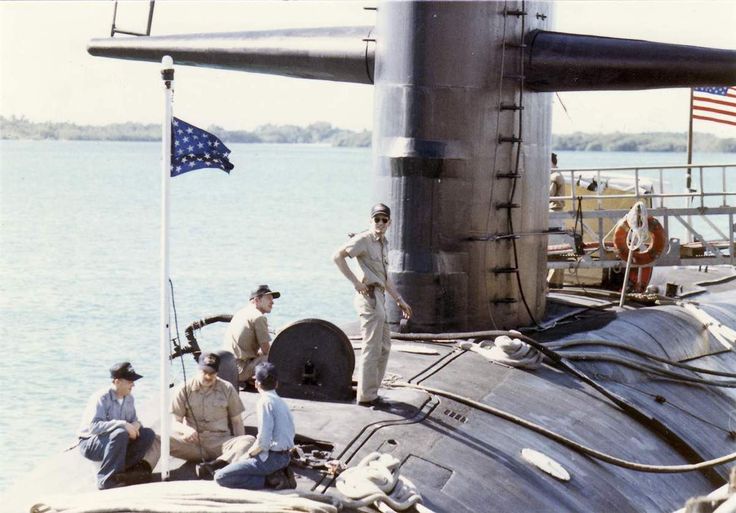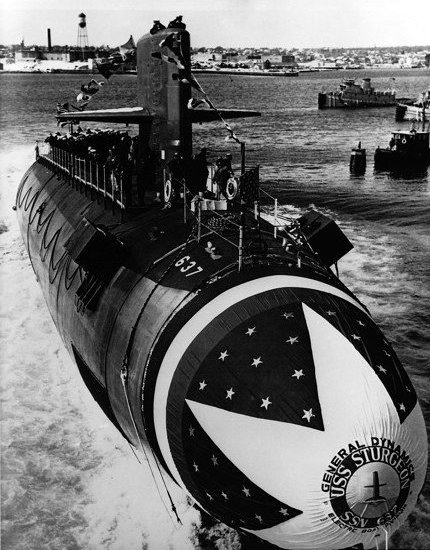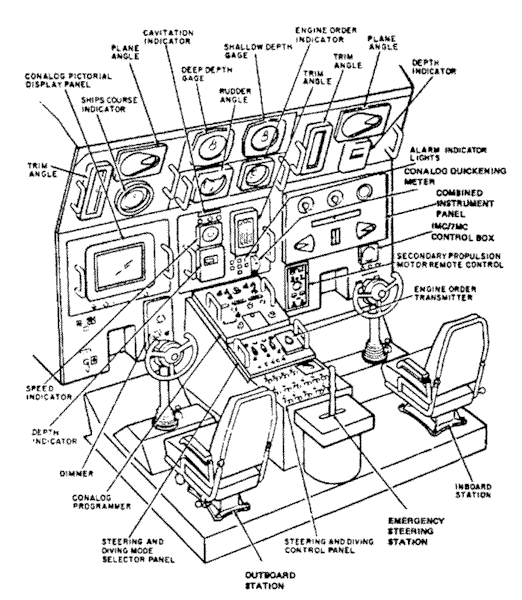Workhorses of the Cold War
Over forty years ago when I first volunteered for submarine duty, one of the hottest boats in the fleet was the boats of the 637 Class. These workhorses were responsible for so many missions during the Cold War that it would be impossible to catalog them all on a single blog post.
Most people will never know how many times these boats performed missions that protected our country. Their missions were secret then and many probably remain so now. But like all submarines, they are only as good as the men who manned them. I salute the service and sacrifice that each crew member made in the defense of this great nation. Submariners receive the designation of “SS” when they become qualified.
Service and Sacrifice seem to fit that title very well.
To all who served on these fine submarines, hand salute.
SSN-637 Sturgeon class
STURGEON class submarines were built for anti-submarine warfare in the late 1960s and 1970s. Using the same propulsion system as their smaller predecessors of the SSN-585 Skipjack and SSN-594 Permit classes, the larger Sturgeons sacrificed speed for greater combat capabilities.
They were equipped to carry the HARPOON missile, the TOMAHAWK cruise missile, and the MK-48 and ADCAP torpedoes. Torpedo tubes were located amidships to accommodate the bow-mounted sonar. The sail-mounted dive planes rotate to a vertical position for breaking through the ice when surfacing in Arctic regions.
Beginning with SSN-678 Archerfish units of this class had a 10-foot longer hull, giving them more living and working space than previous submarines of the Sturgeon Class.
A total of six Sturgeon-class boats were modified to carry the SEAL Dry Deck Shelter [DDS], one in 1982 and five between 1988 and 1991. They were SSN 678-680, 682, 684, 686 were listed as “DDS Capable” — either permanently fitted with the DDS or trained with them. In this configuration they were primarily tasked with the covert insertion of Special Forces troops from an attached Dry Deck Shelter (DDS). The Dry Deck Shelter was a submersible launch hanger with a hyperbaric chamber that attaches to the ship’s Weapon Shipping Hatch. The DDS provided the most tactically practical means of SEAL delivery due to its size, capabilities, and location on the ship.
Rapidly phased out in favor of the LOS ANGELES and SEAWOLF Classes of attack submarines, this venerable and flexible workhorse of the submarine attack fleet has been completely retired now. Attracting little publicity during its heyday, this class of ship was the platform of choice for many of the Cold War missions for which submarines were now famous.
SSN 637 USS Sturgeon
Sturgeon’s keel was laid down by General Dynamics Corporation, Groton, CT, 10AUG63; Launched: 26FEB66; Sponsored by Mrs. Everett Dirkson; Commissioned: 3MAR67 with Cdr. Curtis B. Shellman, Jr. in command; Decommissioned: 1AUG94
USS STURGEON (SSN637) was the third ship of the line to bear the name STURGEON and the lead ship of 37 nuclear fast attack submarines of the Sturgeon-class.
STURGEON departed Groton, Connecticut in April 1967 and conducted her shakedown cruise down the east coast with ports of call in Norfolk, Virginia, Charleston, South Carolina, Ft. Lauderdale, Florida, St. Croix in the American Virgin Islands, and Roosevelt Roads, Puerto Rico. In September she conducted the first of her many extended submarine operations. Upon return to port, STURGEON was transferred to Development Group 2. In January 1968 the boat began a five week antisubmarine exercise to evaluate the relative effectiveness of the STURGEON and PERMIT class submarines.
In late May and early June of 1968 STURGEON participated in the search for the lost submarine USS SCORPION (SSN-589) in the vicinity of the Azores. She then participated in tests and evaluations of a new sonar detection device from December 1968 to February 1969. After a brief visit to the Naval Academy in March 1969 her crew held intense training for her deployment in May. STURGEON was awarded the Meritorious Unit Commendation Medal for her outstanding service in 1968. She received a second Meritorious Unit Commendation Medal for completing a special project for the CNO.
From January to April 1970 STURGEON was deployed. She then spent several weeks aiding and evaluating aircraft anti-submarine warfare tactics and equipment. She also participated in intense submarine exercises and sound trials. From October 1970 until October 1971 STURGEON was in overhaul in Groton, Connecticut, where she received the Navy Unit Commendation Medal for exceptional Service in 1970.
After completing her overhaul STURGEON was transferred to Submarine Squadron Ten based at New London. She completed her refresher training and shakedown cruise and then participated in two antisubmarine exercises before returning to Groton for a restricted availability period. Once completed, STURGEON began extensive tests on sonar systems until the end of 1972.
Starting in 1973, STURGEON conducted extended submarine operations in the Narragansett Bay Op Area. In April she sailed to the fleet weapons range in the Caribbean where she ran aground and was forced to return to Groton in June to repair damage. She then conducted extensive local operations and finally entered Portsmouth Naval Shipyard to effect bow repairs. She remained in the yard until April 1974.
After sea trials and a ten day upkeep STURGEON sailed to Norfolk to join other fleet units participating in Atlantic Readiness Exercise 1-73. In November of that same year STURGEON sailed for the Mediterranean for a six-month deployment with the 6th Fleet. STURGEON spent Christmas and New Year’s in Naples, Italy, and then spent the next few months conducting sea trials, ASW exercises and various other operations in the Med. She returned to New London in May 1975 and conducted post deployment standdown. For the rest of 1975 she conducted midshipmen operations and participated in exercises MOBY DICK and OCEAN SAFARI which ended with a port visit in Rosyth, Scotland.
In June 1976 STURGEON was transferred from Squadron Ten to Submarine Squadron Four homeported in Charleston, South Carolina. STURGEON again deployed to the Med in May 1978 here she conducted many special operations and also participated in the Mediterranean ASW Week and National Week XXV. She was highly commended by COMSIXTHFLT for here outstanding performance. She returned to Charleston in November and commenced a well deserved standdown.
In 1979 STURGEON was again making preparations to deploy. She deployed from June until September and had various port visits which included Holy Loch, Scotland and Wilhelmshaven, Germany. Upon return to port she conducted a Selected Restricted Availability period at the Charleston Naval Shipyard.
In September 1980 STURGEON again departed to the Med where she conducted ASW operations and participated in USN PASSEX with the 30th Airwing of Italy. She returned to Charleston in February 1981 for standdown and upkeep. In August 12981 STURGEON participated in OPERATION OCEAN VENTURE 81, Phase IV and crossed the Arctic Circle on 1 September 1981 at 006 41′ East. She was awarded the Battle Efficiency “E,” engineering “E,” the Antisubmarine Warfare and Operations “A” and the Damage Control “DC” for fiscal year 1981.
From January to March 1982 STURGEON conducted special operations. She was the first U.S. nuclear submarine to visit Brest, France, and the first U.S. nuclear submarine since 1969 to visit any French port.
In March 1984 STURGEON provided support for a multi-national task group engaged in amphibious operations in the eastern Atlantic and Norwegian Sea. She also visited Trondheim, Norway where she hosted the Lord Mayor of Trondheim, Commander Trondelag Naval District, and the U.S. Ambassador to Norway.
During January 1985 STURGEON provided vital SEAL support during diver operations. STURGEON at that time completed a record number Lock Ins/Lock Outs for SSN diver operations. She also conducted a number of SEAL full mission profiles and developed new techniques to improve success, particularly in the area associated with rendezvous and recovery. In February STURGEON conducted two special CNO operational evaluations on USS FLYING FISH (SSN-673). In March STURGEON hosted commander Submarine Group SIX.
RADM Stanley Catola, and a group of local businessmen and community leaders on a dependent’s cruise. STURGEON then entered the yards for a non-refueling overhaul at Charleston, South Carolina Naval Shipyard which lasted until November 1986. While in the yards, STURGEON updated her Sonar to the BQWQ-5C, Fire Control to the CCS MK-1 and gave the ship the capability to shoot Tomahawk Missiles.
In early 1987 STURGEON completed all tests and certifications for here new systems satisfactorily. In August she deployed to the Mediterranean, the first deployment since 1985. STURGEON remained in the Med for the rest of 1987 and while there developed new operational procedures for employment of the MK-67 SLMN mines. She returned to Charleston on 31 January 1988.
1988 was highlighted by STURGEON passing a surprise ORSE with superior performance, a TRE with a grade of above average and a NPTI with a grade of outstanding in 10 of 12 categories. She then went into SRA to update the fire control system to give her the capability to shoot ADCAP MK-48 torpedoes. For her efforts in fiscal year 1988 STURGEON was judged as one of the outstanding submarines of the Atlantic Fleet. The boat was awarded a second consecutive Battle “E”, engineering “E” and the Supple “E” for Submarine Squadron Four.
In March 1989 STURGEON deployed to the Arctic Ocean for ICEX 1-89. While deployed she hosted a Congressional delegation on the ice pack. STURGEON also conducted several missions of scientific importance and a joint operation with the British Navy to further develop ASW capabilities. She returned to homeport in June. In September 1989 Hurricane Hugo devastated the South Carolina coast. STURGEON remained in port due to a Steam Generator Inspection and came through the storm with no damage. In the aftermath of the storm STURGEON sailors assisted the local community and provided assistance to 643 families.
STURGEON was again deployed from June to September 1990 and was awarded the Battle “E,” Engineering “E,” ASW “A,” and the Supple “E” for that fiscal year.
In January 1991 STURGEON was included in the highly successful operation SWAMP FOX, a multi-unit exercise that took her to a port visit in Roosevelt Roads, Puerto Rico. From April to June STURGEON completed another highly successful deployment. STURGEON then entered a Selected Restricted Availability and underwent a complete refurbishing, leaving the drydock in mid-October. For her effort in 1991 STURGEON once again was awarded the Battle “E”, ASW “A”, and the Communications “C.”
1992 saw STURGEON completing another highly successful exercise SWAMP FOX 92. After the exercise STURGEON spent a week in Cap Canaveral, Florida. In late August, STURGEON deployed to the North Atlantic, diverting to Faslane, Scotland for repairs. After leaving Faslane for tests in the Irish Sea, STURGEON became entangled in an Irish fisherman’s net. No one was injured and minor damage was done to both vessels. STURGEON then returned to Charleston for repairs.
1993 was STURGEON’s final full year of operation. Intensive training for a highly sensitive CNO project occupied the majority of STURGEON’s time. However, STURGEON had a chance for a port visit to Port Everglades, Florida in July. In early October STURGEON departed Charleston to participate in SWAMP FOX 93-1 and then deploy. STURGEON returned to Charleston in late November following the completion of another very successful deployment.
In December 1993 and January 1994 STURGEON’s crew once more conducted an intense upkeep, preparing for her deactivation ceremony, several short operations, and final transit to Bremerton, Washington for decommissioning. She was deactivated in Charleston, South Carolina on January 14, 1994, and decommissioned on 1 August 1994. She was scrapped at Puget Sound Naval Shipyard, 11 Sep 1995.
On September 15, 1995 at the Naval Undersea Museum in Keyport, Washington, a ceremony commemorated the transfer of the USS STURGEON (SSN637) sail from Puget Sound Naval Shipyard. The sail, now located in the museum parking lot, is the only detached sail from a nuclear fast attack submarine on display anywhere in the United States.
Correction from a shipmate: I really enjoy your posts. However, I would like to point out that my qual boat, USS Lapon (SSN 661) sail is on display at American Legion Post 639 in Springfield Missouri. Lapon was also a Sturgeon Class boat.
So Apparently there are two! Good to know but the bucket list just grew again.
The USS Surgeon and I were both decommissioned on the same day (August 1, 1994). As I look at the world around us, I sure do wish both of us could sail again to counter the threats that are emerging. Thank God we have new boats and new submariners willing to raise their hands (twice) and service this great nation.
Mister Mac








I really enjoy your posts. However, I would like to point out that my qual boat, USS Lapon (SSN 661) sail is on display at American Legion Post 639 in Springfield Missouri. Lapon was also a Sturgeon Class boat.
I did not know that and will add a correction in the morning. Thanks
The sails of two other SSNs, (Parche, and Triton) are also on pulbic display
I also enjoy your posts. My qual boat, USS Tunny (SSN 682), besides being a DDS-capable “637-stretch” was also a Deep Sea Rescue Vehicle (DSRV) Mother Ship (MOSUB). I don’t know how many other Sturgeons had those (not-so-) wonderful holes drilled in their decks, but I’m sure there were a few.
Just thought I’d mention that, along with all the other great things those boats did, they were also designed to help. 🙂
I still find it interesting that for a class of submarine supposedly designed to be “blue-water,” 688’s couldn’t dive as deep as Sturgeon, nor do they handle as well in shallow water. I guess there’s just a special place in your heart for your first boat…
Each boat had their own qualities. I was a 688 sailor twice and enjoyed my time on the 711 boat. Sadly my time on the 697 was spent trying to get her out of the shipyard in Pearl but she also had an honorable service life. I think every boat sailor that I have ever met has a soft spot for their first. As much as the 598 almost killed me twice, I still look back on the experience and am amazed that we actually did the things we did. Thanks for the feedback. Mac
Reblogged this on Dave Loves History.
Parche’s (683) sail is on display at the Naval museum in Bremerton and Drum’s (677) is at Great Lakes. There are probably others as well
Sails of many attack subs are rusting in cities around the country,from Buffalo to Cincinnati.
Served on 637 twice. It’s difficult to imagine any new boat surpassing our exploits and (uh oh, can’t say that) the survival capability. Nearest thing to my diesel boat experiences. Stanley Catola was noted, served with him on SS-242, when he was a j.g.
I can fill in a little more history from the early 80’s. November ’82 participated in local ops and a port call in Port Canaveral FL. Dec ’82 – Naval Weapons Station Charleston for Steam Generator inspections. Jun-Nov ’83 – deployed to the Med, making port calls in Naples It and Toulon Fr.
The photo near the top of the webpage was taken pier-side in Roosevelt Roads PR during the SEAL Ops in Jan ’85 which you described.
The USS Hawkbill (SSN-666) sail now resides as a monument in Arco, ID.